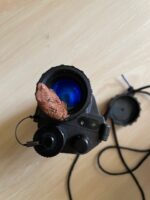Month: October 2025
How to protect your NV investment
A quality night vision device like one of our PVS 14s or a dual tube set like a Katana, MH1, ARNVG, etc. is going to stand up to a lot of use and a fair amount of ABuse..
That being said, quality night vision is expensive. Yet for all the times we have heard “it’s three thousand dollars!” on a PVS 14 we have also seen some as many examples of people just literally abusing the systems.
There remains a few simple common sense things you can- and should- do to protect your night vision investment.
#1. Remove the battery(s) every single time your done for the night. Period, end of statement. We mention this in the “quick user guide” customers are sent with their tracking email on NV orders, in the paperwork shipped with NV devices as well as every time a customer asks about NV on the phone. I have been “challenged” online once about this, with someone stating that “you don’t know my operational parameters.” Well, no, but everyone over the age of FIVE knows when it’s starting to get dark and since night vision is only useful at night, well let’s say you will know a little ahead of it’s need and since it takes all of about 5 to 10 seconds to install a battery in a PVS14, I don’t see this as a reason to RISK damaging your unit.
Also, anyone who has worked with gear in the field, been in the military or just done an extensive amount of training over the years, knows that there are certain things you do at certain times- i.e, pack any gear away that you needed at night (sleeping bag, etc.) before first light. This is just normal SOPs stuff for living in the field. At a defensive position or retreat, the same type of SOPs apply.
So how exactly do people screw this up??? I have a theory. It’s usually people that don’t work with their NODs regularly, most likely haven’t trained with them (just like your gun, you need training with your NODs). Therefore they don’t realize the need to remove it.
“But Robert, is this really a big deal?”

This is one of the most recent (and bad) examples of what a battery left in a NV device will do. In this case the corrosion was so bad as to stop the unit from working. We have seen customers send some where the damage was so bad it required a new PVS14 housing ($700. or more). Note- no company covers this kind of customer negligence in their warranty and neither do we. This particular one was so bad we weren’t sure we were going to get the battery cap off to begin with.
Some of these customer negligence issues can be cleaned up and fixed, some require the change out of the housing. All because the battery wasn’t removed.
Battery out, every single time, no exceptions. Get into that habit and your grandkids will be using your NODs. Be lazy and negligent and your unit will stop functioning- maybe even at a time you really need it!
#2. Cover your lenses when done.
You don’t need “iris” or refocusing devices, the standard black “pinhole” aka “daylight” cover for the objective (front) lens is fine. We ship units with throwaway black plastic caps covering the eyepiece (rear) lens also. Keep them for storing the unit as well.
Lenses aren’t cheap, especially quality lenses like we use. An LIF and a sacrificial window is helpful to avoid bumps and scratches in the field.
3. Tether your unit. When mounting to a helmet, Crye nightcap, etc. be sure to add some sort of tether to your device from the helmet. This could be a commercially produced tether or something you made yourself as simple as a piece of cord attached to the unit tied to the helmet mount.

This is how one of our rental gear PVS14s was returned by a student a few years ago, well, he put the daylight cover on to hide the mud… Now when we set students up with rental gear, we tie the unit to the mount after it’s installed. So technically this shouldn’t have happened, but the student untied it, then later dropped it and somehow just forgot to mention it… It cleaned up fine but goes to both #2 and #3 here. Had we been in a region with rocks instead of mud, this could have damaged the objective (front) lens and necessitated a $300. plus repair. Tether.
You invested money in your night vision device, be smart with it, do these things mentioned above to protect your investment.
